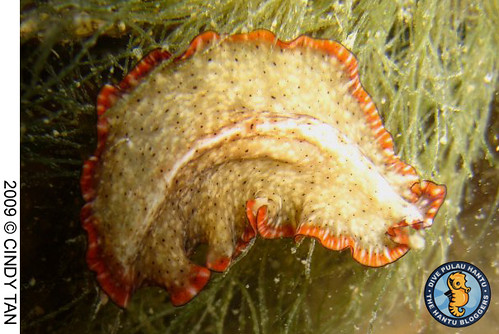 January 8, 2010
January 8, 2010

They’re called flatworms, but the name does little to describe them apart from the fact that they were, well, flat! Finding a flatworm on the reef can be as exciting as spotting a brilliant nudibranch. As these pictures as testament, flatworms come in an array of colours that may include texture and intricate patterns. Flatworms are from the Phylum Platyhelminthes, and are the simplest of the worm group. It is soft-bodied, unsegmented, has no skeleton no body cavity, and no specialized Circulatory system and Respiratory system. They have a combined digestive/excretory system – taking food in and getting rid of wastes through the same opening, like sea urchins and sea cucumbers! They also have a central nervous system and a simple brain to co-ordinate their well developed muscular system.
Read the rest of this entry »
 Posted in Blog Log, Photography
Posted in Blog Log, Photography  No Comments »
No Comments »
 December 28, 2009
December 28, 2009

Image: Tamara Shopsin and Jason Fulford
December 26, 2009
The New York Times
For the many disappointments of the recent climate talks in Copenhagen, there was at least one clear positive outcome, and that was the progress made on a program called Reducing Emissions From Deforestation and Forest Degradation. Under this program, key elements of which were agreed on at Copenhagen, developing countries would be compensated for preserving forests, peat soils, swamps and fields that are efficient absorbers of carbon dioxide, the primary heat-trapping gas linked to global warming.
Read the rest of this entry »
 Posted in Climate Change, News
Posted in Climate Change, News  2 Comments »
2 Comments »
 December 20, 2009
December 20, 2009

Once again, Blog volunteer Jimmy Goh returns from a trip at Hantu Island with some fascinating macro insights into local seas. What a lovely perspective of these usually skittish animals! (Above: Ornate goby)
Read the rest of this entry »
 Posted in Blog Log, Photography
Posted in Blog Log, Photography  No Comments »
No Comments »
 December 17, 2009
December 17, 2009

The effects of ocean acidification on corals are particularly concerning since one quarter of all marine species depend on coral reefs for homes, nurseries, feeding grounds and spawning sites
Ocean acidification is the process caused by increasing man-made carbon dioxide emissions, by which the oceans are becoming more acidic.
When carbon dioxide enters the ocean, it combines with seawater to produce carbonic acid, which increases the acidity of the water.
Rising carbon dioxide emissions, primarily from the burning of fossil fuels for energy, has led to a 30 per cent rise in ocean acidity from pre-industrial levels, as measured by a fall of 0.1 units in the pH of ocean surface waters.
If carbon emissions growth continues at the current rate, the pH of ocean surface water will fall 0.2 units by 2050, lower than at any time in the last 20 million years. By the end of this century, the pH will have fallen 0.4 units from its natural level – close to a doubling of ocean acidity. The change is happening 100 times faster than at any time in the history of the planet.
Read the rest of this entry »
 Posted in Uncategorized
Posted in Uncategorized  No Comments »
No Comments »
 December 17, 2009
December 17, 2009

Rising carbon emissions could hit fish stocks around the world
Previous studies have focused on the impact of acidification on coral reefs but not other marine organisms
Commercial fishing in the northern hemisphere will be devastated by rising carbon emissions, according to the first major study into the impact of ocean acidification.
A report by the marine NGO Oceana, presented to delegates at the Copenhagen Climate talks this week, has highlighted how higher acidity disrupts all marine organisms abilities to grow, reproduce and respire.
The worst affected countries, based on current fish catches, consumption, the importance of coral reefs and projected level of acidification in their coastal waters, are expected to be Japan, France and the UK. The United States and China are also expected to suffer.
Read the rest of this entry »
 Posted in Uncategorized
Posted in Uncategorized  No Comments »
No Comments »
 December 6, 2009
December 6, 2009

Last Sunday, a full boat of veteran and brand new divers to local waters, took to the sea with the Hantu Blog dive guides. Despite the onset of the monsoons, the weathered stayed fair and sunny all through the day. Reportedly, the underwater visibility was also very accommodating, which made the first dive into Singapore waters for some first timers a little more comfortable! I might give a huge Thank You to volunteer dive instructor Jimmy Goh for once again sharing his experience of Pulau Hantu with us by taking the effort to take these wonderful photographs while guiding newbie divers (it’s a big effort!). Jimmy’s photos have been featured on the blog several times, and have received a lot of positive comment from our readers. So to his favour I have to admit that if you’re wondering why the pictures in this post look a little different from his pictures in earlier posts, it’s because he’s using my camera, which is an inferior model to his! (Above: Slender Ceratosoma nudibranch)
Read the rest of this entry »
 Posted in Blog Log
Posted in Blog Log  1 Comment »
1 Comment »
 January 29, 2010
January 29, 2010 

 Posted in
Posted in 













 content rss
content rss
COMMENTS